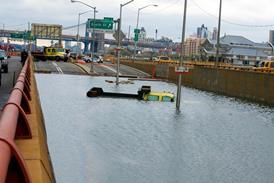It has been recognised that the Social Exclusion Unit's report on rough sleeping focused mainly on London, and with the recent appointment of the new head of the London rough sleepers unit, it's time to focus attention elsewhere. Outside London 2,000 people have been estimated to be sleeping rough.
The new Homeless Action Programme, in tandem with the objective for each local authority to have a single homelessness strategy, provides good opportunities to integrate work with homeless people within mainstream local and regional policies.
There needs to be active involvement of all the key agencies in developing local strategies including the lead role of local authorities, with health authorities, voluntary sector providers, housing associations, the police, employment service, probation service and other agencies. Essential too is the involvement of the local business community. This has been the Bristol experience with a city-wide consortium led by Bristol city council. There is also a big opportunity to link government plans on reducing rough sleeping with a raft of new initiatives including the New Deal, New Deal for Communities, and also with the wider economic regeneration strategies of the new Regional Development Agencies.
What's important in all of this is that local communities provide their own solutions to problems. Critically this means that homeless people must be involved in the design and implementation of local strategy. This is one way of interpreting Best Value at street level - putting homeless people at the centre of planning and delivery of provision. As an example, Bristol Cyrenians undertook a pilot project called Making a Difference, funded by Homeless Mental Illness Specific Grant, which enabled up to 30 people with histories of rough fed into local strategy. Also a group of rough sleepers using the cold weather shelter were closely involved with the planning of a temporary direct access hostel under the previous Rough Sleepers Initiative. The challenge has to be to get real involvement by people and this has been a constant feature of Bristol Cyrenians outreach and resettlement, day centre, supported and emergency housing projects over the last 10 years.
In the local patch, there are ward by ward differences in what the needs are and a local response has to be the way forward. This means inevitable tensions with a programme which is centrally funded. Beyond 2002 we may see funding subsumed within the Supporting People framework whereby local authorities will have a single pot of funding. There must be an opportunity for "joined up" funding programmes and new models to respond to individuals with a range of interconnected needs.
The ambition is to achieve a significant reduction in rough sleeping.
Significant capital and revenue funding in Bristol means that the number of people sleeping rough is half the figure three years ago, as established by bi-annual street counts organised by the local authority.
But we all know the problems of homelessness are more complex than this and it is hoped that the Department of the Environment, Transport and the Regions will develop more sophisticated performance indicators over time. The complex problem of homelessness is changing and evolving and it will be essential to develop indicators to measure achievement against targets that cannot be static.
Our challenge now as local agencies working to reduce and alleviate homelessness is to work in partnership with statutory and private sector agencies. We need to translate cross-departmental thinking into local horizontal action and ensure that homeless people are part of this.
The tapered funding regime whereby voluntary sector providers are fully funded in year one, funded at 75 per cent in year two and funded at 50 per cent in year three, is based on the premise that local agencies must financially contribute towards the reduction of homelessness. This can be problematic with the conflicting demands of local authorities' budgets.
However we know that it is the Prime Minister's personal objective to reduce rough sleeping. To achieve this, we need the alliance of agencies to ensure that homelessness is included as a problem to be resolved within economic regeneration strategies of Regional Development Agencies and local authorities. Bristol Cyrenians' skills and learning initiatives are all about prevention of homelessness and linking homeless people to training, education and employment resources. By linking initiatives and funding, we will be integrating short term government resources within longer-term strategies to develop communities of well being, with the first step being to have somewhere safe and secure to live.
This will cause "resettlement" to be reinvented as the essential conduit for other initiatives to make the reduction of rough sleeping both achievable and sustainable in the long term.
Source
Housing Today
Postscript
Paul Watson is director of Bristol Cyrenians.





















No comments yet